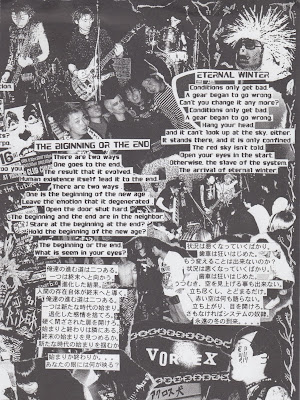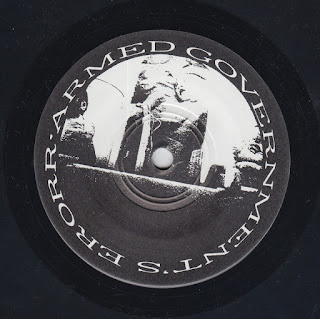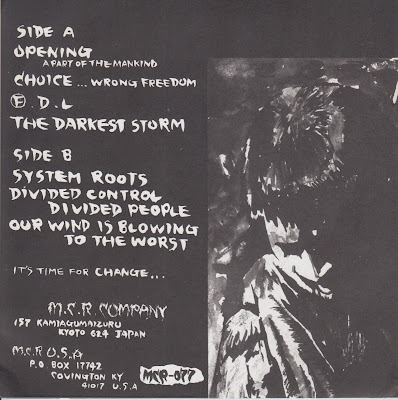This record makes me a little nostalgic actually as it takes me back to an exciting time when I was proudly flying the "No war but the crust war" flag and trusted the label for top crust records with my life (as well as with indecent shipping costs sometimes, this goes without saying). Thinking about the 2002/05 crust period retrospectively is interesting. In the grand Crust Narrative, these few years are situated just before the so-called stenchcore revival of the mid-noughties which - although it admittedly did produce some good records - certainly changed the way crust music was being looked at, further sectioned the genre and turned what were essentially takes on the genre into the genre itself by giving it a new name: stenchcore. That it coincided with the rise of the internet culture from the mid-00's onwards should be no surprise and the growing codifications it implemented have become today's norms. But this Lp, along with the Effigy records of the early 00's, also made me realize something else, that Japanese crust (and indeed Japanese punk music on the whole) is, to a large extent, oblivious to the punk trends regularly sweeping across the rest of the world. They just seem to do their own thing in their own context and I highly doubt the short-lived 00's stenchcore revival had any significant influence on Japanese crust bands (Hellshock being arguably an exception in that respect, but then, if anything, they were themselves highly influenced, in terms of intent more than sound, by Japanese crust music), which accounts for the usually high quality level and the sound specificities of crust bands over there.
This record also makes me giggle a little as I am reminded of how people reacted to it at the time. They were all pretty unanimous (and, by and large, still are). Contrast Attitude's side absolutely ruled, but what was that cheesy heavy-metal band doing on the B-side of a hardcore/crust record? I would be a rich punk (understand "I could buy a decent brand of lager for a change") if I had had one euro each time I heard "I have never even listened to the full Acrostix side... That shows how much it sucks. I mean... who do they think I am? Some hard-rock fan with greasy hair? I only bought it for Contrast Attitude anyway because I <3 D-beat and that". Almost 13 years after its release, the general appreciation of the Lp has not really changed and you can be sure that Contrast Attitude will be raved about while Acrostix will be promptly discarded (to be fair, some people did get into "(A chain of) hatred" later on though). As for me, as much as I enjoyed CA, I always preferred the Acrostix side. Sure, they were not a hardcore-punk band at all on the Lp, but I loved the fact that, while they sounded familiar through the heavy Amebix/Axegrinder influences, they also sounded really different from what I knew at the time, with the epic layers of synth and the strong ballad vibe. It was crust music but it felt like they had picked one aspect of old-school crust - in this case the rocking melancholy vibe of "Drink and be merry", "Right to ride" or "The final war" - and assiduously worked on it in order to tell a different side of the Crust Story. And I bloody loved that idea. Of course, I now have a much more articulate idea of what the band originally was going for and where they coming from in their early days, but despite the more cerebral view I acquired, I still see these three Acrostix songs as genuine masterpieces and proper attempts at telling the story distinctively, from a different but complementary narrative position if you will. It is quite ironic and even sad that crust music became so generic and forceful shortly after.
Like Contrast Attitude (with whom they shared a member, bass player Sin), Acrostix were from Matsusaka, in the Mie prefecture. The band's birthdate is unclear but seeing that their first appearance on a record was in 2002, it is safe to assume that they formed not long before that. On the paronomasia front, "Acrostix" is actually a great name methinks. Beside the "-ix" suffix obviously nodding toward Amebix (and they did nod a lot), undeniably the band's primary influence, referring to the concept of the acrostic was a clever move and I see it as a comment on songwriting and how by changing the order of elements you can create something that is both new and yet rooted in a tradition. The constant retelling of a story that changes with each telling and narrator and yet retains its intrinsic meaningfulness. And it sounds great as well, but I am grateful they did not go for "Acrustix", it would have been too corny.
If the first appearance of Acrostix, with the original version of "Filth chain" on the "Crust night 2002: the war begins for them!!" compilation cd on Tribal War Asia, did give a few hints about the band's identity, it still very much had an incomplete feel. Basically a raw rewriting of "Arise!", the song had some solid Effigy-like riffing (another important early influence) but lacked that groovy atmospheric vibe that made Acrostix stand out. The second effort, the self-titled four-songs demo recorded in late 2002, was more convincing, if still on the raw side of things. Keeping building on the Amebix gloomy rocking sound, especially with the omnipresent groovy bass lines and the raucous but distinguishable vocals, the songs were heavy but not in a punishing way as they relied more on vibe than sheer power. But it was on "The darkest 4" tape (a four-way split between Acrostix, Effigy, Disturd and Zoe) released in 2003, that Acrostix truly took off. Despite a rough production, the band made a choice that proved to be a game-changer and considerably improved the atmospheric quality of the songwriting: they added a synth. And not just a little of it, no, they completely went for it, ballistically. The synth provided that extra texture, a new meaningful layer that fitted and further developed the melancholy vibe of the amebixy numbers perfectly. The song "The day comes" paved the way for what was to be the apex of the early Acrostix period: "Awave!".
Now, before I go on with the Lp I am actually here to discuss, just a few words about synth-driven crust music, because that is exactly what we are dealing with here. Of course, Amebix did use the synth on some songs (on "Arise!" and especially "Monolith") and at the end of their existence, they even had a full-time synth-player on stage, George. Although the synth was undeniably crucial in establishing and enhancing that gloomy, monumental, otherworldly vibe that Amebix created, it was still mostly used as a textural layer, as a means to an end, rather than an actual instrument on par with the guitar or the bass, although some moments on "Monolith" were certainly synth-driven and pointed in that direction. It was in this interstice that Acrostix flourished, by taking the "Monolith" mood and vibe and adding a new structural voice with a more important role being given to the synth. Building on the Amebix synth-tradition, some bands had used it afterwards, often parsimoniously, like Axegrinder on their Lp, Saw Throat, Counterblast, Filth of Mankind in a very meaningful way and Morne (their 2008 demo being a masterwork on that level).
Of course, the "Monolith" period and the few songs recorded afterwards by Amebix remain Acrostix' primary pool of inspiration, however there has always been one scene, oft forgotten, heavily into synth and old-school mid-paced groovy crust: Greece. And that is exactly where I pinpoint the other main songwriting influence of Acrostix. A quick look at Acrostix' side of the Lp's cover gives the game away for me. It depicts a wolf howling to the sky. Now I am aware that it is not exactly the most original motif in the world of punk and metal (and to be honest, the cover is the one thing I do not really like on the Lp, well, along with the celtic cross on the "o" of Acrostix, it does not roll that well on a shirt in Europe, does it?), but I am definitely reminded of the cover of Χαοτικό Τέλος' "Μπροστά Στην Παράνοια" Lp from 1993 that has wolves howling in a moonlit forrest (flying crow included of course). Even more so since Χαοτικό Τέλος had possibly been the most synth-driven crust band so far and their 1991 tape "Πέρα Από Τα Τείχη Της Σιωπής" remains, to this day, the best example I can think of synth-driven "amegrinder" apocalyptic crust music. I may be reading too much into the wolf reference but Acrostix cannot not have been aware of Greek synthcrust (there is another subgenre for ya) and despite significant discrepancies between the sound of Acrostix and Χαοτικό Τέλος, I do not think I am mistaken to think that the former took some important cues from the latter and Greek crust as a whole in terms of arrangements and placements. Interestingly the release of the split with Contrast Attitude coincided with that of another synth-driven crust record (despite the rarity of this take on the genre) in the shape of Χειμερία Νάρκη's "Στη Σιωπή Της Αιώνιας Θλίψης" in late 2003 (yes, Hibernation if you prefer).
On the Lp, you will therefore find three songs of synth-driven mid-tempo dark and rocking heavy crust music with a distinctive Japanese feel in the guitar (that crunchy distorted sound being the trademark), groovy bass lines and half-sung/half/shouted vocals. As I mentioned several times, the late-Amebix influence is all over (literally with songs called "Awave!", "Eternal winter" or "The biginning of the end" and the "Amebirider" drawing that blends Amebix' face with the Hellbastard one, just in case it was not clear enough) and Acrostix do manage to recreate this deceptive simplicity, organic, earthy and atavistic with an incantatory quality, although they also add some punch and intensity thanks to a great production and an emphatic songwriting intentionality. The three songs blend with each other so I left them on a single track as it stresses their flowing atmospheric quality. The standout number here is the closing one, "Eternal winter" with an epic and ethereal intro where Sin the Baron (also on the bass, quite obviously...) sings for real (and I mean SING) before the song builds up into an intense, crunchy, catchy, gloomy crust anthem with simple yet amazingly effective bass lines and top tunes. That is melancholy crust and rocking bleakness you can actually dance to, unique and yet heavily referential. Japanese crust at its best. Following this split Lp, Acrostix took a different musical direction, adding a lot of punchy Japanese hardcore to their recipe, and, although very powerful, I never was quite as taken by their (synthless) later records, even if I must admit that I do like the "Truth turned gray with justice" Ep from 2008 and the sax-driven (yes, you read correctly) crust song on the B-side.
The other side of the Lp, poetically entitled "Now the world is from CHAOS to another more CHAOS...", has four songs from Contrast Attitude who have a very different take on the whole thing and that often makes for great split records, right? Looking at the foldout cover, you can pretty much guess what CA are all about with the use of the Discharge font and "D-beat till death" being proudly stated... or can you? CA are not really a D-beat band and although they do make use of the beat and of some riffing, they are in no way as orthodox as Disclose or Final Bloodbath for instance and sound like a much more versatile bunch with one idea in mind: hardcore intensity. Not quite as monomaniacally systemized as Disclose, as crustily insane as Gloom nor as hyperbolically relentless as Framtid, CA are maybe somewhere in the middle. There is a noize element in the guitar but it is not exaggerated, it is fast and punishing without being manic, heavy and thrashy but not really metal, catchy and with a fist-raising intent but never going into Burning Spirit territory... CA are a balanced band if you think about it and the songs, without ever being truly memorable, are clearly effective and well written. The four songs on the split Lp have a great sound which highlights their modernity as I never felt the band tried to go for old-school or openly referential. The drumming is super tight, as usual, with a delightful pummeling crasher crust feel, the riffs are good and bring Diatribe or Broken Bones - more than Discharge - to mind, the yelled vocals are intense, direct and harsh but never forceful and on the whole there is an undeniable hardcore energy and spirit permeating the sound through smart hooks and tempo changes. The production may not be heavy enough on this particular recording but the songs remain top-shelf in their style and I can definitely imagine them being particularly great live (like a useless fool, I missed them when they toured in Europe a few years ago). CA have been going since 1998 and still deliver the goods which is something that I always admire.
The foldout is quite good-looking with an abundance of visual references to Discharge, Amebix or Antisect and you have got plenty of band pictures for added crustness. I am not such a sucker for the covers however as they are pixelated and have a real "early digital imaging" feel, and I guess they should have gone for the old-school DIY punk look of the inside. Oh well, it was another time. And good news, as this quite wonderful split Lp still goes for cheap today and can be obtained for a tenner. The gods of punk-rock are sometimes undecipherable.
























































